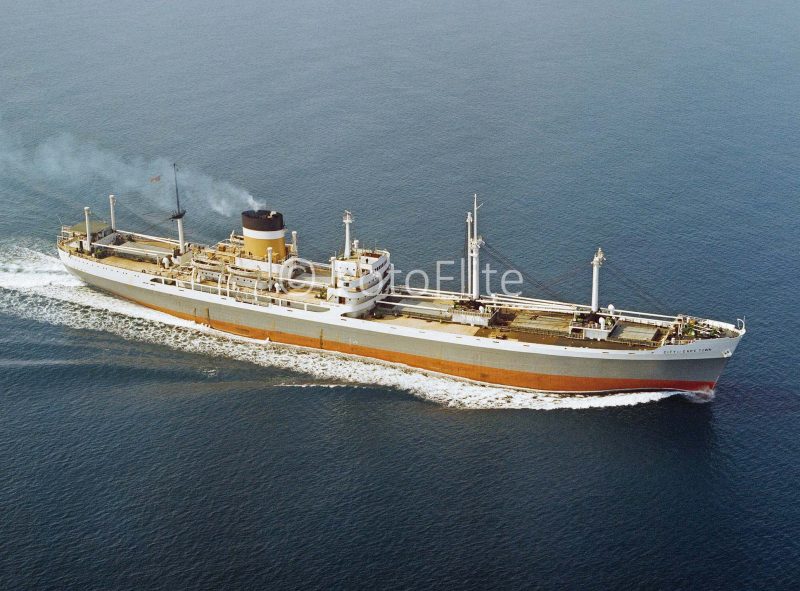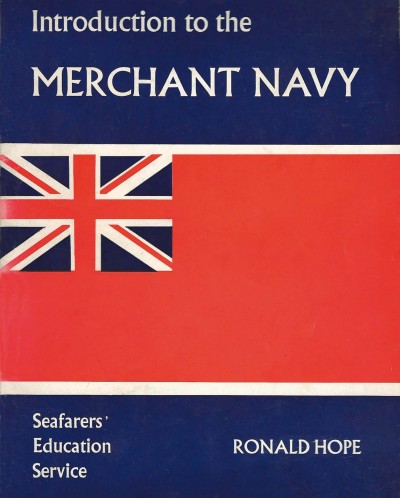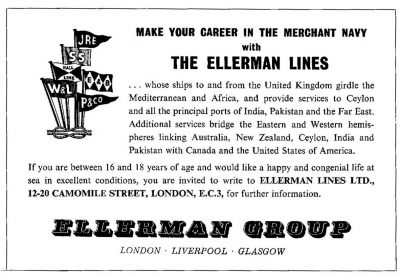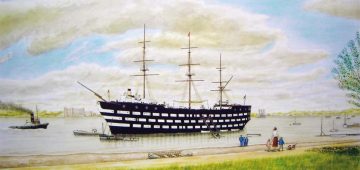MV City of Cape Town (April-July 1971)
by David Harris
I grew up in a wet, wintry, windy town in Scotland. I was an average student at school but knew that I did not want to stay on after sitting my O levels at 16 and certainly did not want to work in a local shop or office for the rest of my life. I spent a lot of time in my youth reading travel books and listening to my shortwave radio. There was a great big exotic world out there and somehow I wanted to discover it. At lunchtimes I would go to the school library and start browsing through the careers section. I had no idea of what I wanted to do but felt that if I went through all the literature I would get some inspiration. Suddenly it came to me – a wonderful opportunity to escape small town life, explore the world and get paid for it. I would join the Merchant Navy as a Navigating Officer cadet! I wrote to the Seafarers Education Service, enclosing a five shilling postal order and received a copy of a booklet entitled “Introducing the Merchant Navy”. This 80 page booklet began with the propitious words:-
Any young man worth his salt wants to see the world, and in the Merchant Navy he is able to see it
The booklet, which I still have in my possession, went on to list the major shipping companies and their routes. There were advertisements from a number of major firms but for some reason I wrote to Ellerman Lines Ltd. I think I liked the idea that they seemed to serve most parts of the world. I do not remember what I put in my letter but much to my surprise I was invited to an interview at their Glasgow office. The interview was quite brief and I was asked a few general questions and then asked to wait. A few minutes later a lady came out and told me that I had been successful. They wrote to me to confirm my appointment as Navigating Officer cadet on the princely sum of £7 per week and informed me that I would be going to the School of Navigation and Maritime Studies, Plymouth College of Technology (now part of the University of Plymouth) in September 1970 to begin my training. I had just left school with a rather modest 6 O Levels and got a job in a local supermarket to tide me over for the summer. The six months at Plymouth passed fairly quickly and included some boat work sessions in Plymouth Sound and a day cruise on the college’s own sailing vessel, Tectona. This fine vessel was built in India in 1928 and is still in use but now owned by the Island Trust. Some of my fellow students had already been to sea but for most of us it was a mystery. What was it really like to live and work on board a ship for months on end? The mystery was soon to be unravelled. Shortly after the college course finished I received a letter instructing me to join MV City of Cape Town at the Royal Albert Docks in London for a 3 month return voyage to South Africa.
It was a requirement of the college course that all students keep a journal throughout their time at sea. I duly bought a large foolscap notebook and kept a detailed record of my time at sea. This article is about my first trip to sea in 1971 which I duly recorded in the journal which I have kept but had not read for over 40 years.
A long overnight train journey took me from Scotland down to London and then a taxi ride to the docks. I looked up at the fine vessel that was the City of Cape Town and was to be my home for the next three months. I walked up the accommodation ladder and asked the Indian seaman on gangway duty to direct me to the Captain. He showed me to the mates office where a number of officers, some who appeared to be a bit the worse for wear, were gathered. I introduced myself and was told to go upstairs and see the “Old Man”. The Captain seemed less than interested at my arrival and I was promptly despatched back down again to the mate’s office.
Another cadet, who was nearing the end of his cadetship showed me my cabin and after I had unpacked I was shown around the ship and given some idea of what my duties would be in port.
City of Cape Town (IMO 5073882) was one of about 50 general cargo vessels in the Ellerman fleet in 1971. She was built in 1959 at Alexander Stephen & Co, Linthouse, Upper Clyde, Glasgow. Originally named City of Melbourne she had sailed on routes to Australia until containerisation had made this service uneconomic and she then transferred to UK-South Africa route and was renamed City of Cape Town in 1968. She was 9,914 tons gross, 5,312 tons nett and 12,300 tons dwt. Length overall was 545 ft. She had five cargo hatches and was powered by a 12 cylinder 14,700 h.p. diesel engine.
Reading the journal today, the most surprising statistic about this vessel was the number of crew she carried. In my journal there is a meticulously drawn crewing diagram shows that there were no less than 81 personnel (28 British Officers and NCO’s and 53 Indian crew). We carried no passengers but I am sure that all hands worked hard and that every surface of the ship was repainted every voyage. On the engineering side there were 9 officers plus 2 electricians, a refrigeration officer and 2 cadets. The engine room was not automated and 2 officers would have been on duty at any one time. On the deck side there were the Master, Chief Officer, Second Officer, Third Officer, 2 cadets, a British carpenter and 3 British Quartermasters (QMs). The British NCOs had their own mess but were allowed to use the bar. There was a radio officer, employed by Marconi, and 2 British pursers. The Asian crew who came from Bombay consisted of 18 engine room ratings and 22 seamen. The 12 catering staff came from Goa. The Asian seamen were accommodated in the poop house where there were 4 bunks to each cabin. British officers and NCO’s had their own cabins amidships but I think only the Captain and Chief Engineer had their own bathroom.
My journal begins on Wednesday 20th April 1971, with the ship at No13 berth, Royal Albert Docks (now the site of London City Airport) and describes carrying out cargo watches as we loaded vast quantities of Scotch whisky in cartons. I recall that quite a lot of bottles were broken in the loading and the stench of whisky pervaded the ship. To this day I cannot drink whisky and the smell of it takes me straight back to those days. It seems strange that the cartons were not palletised. Every single carton of 12 bottles was transferred into the hold by cargo net and then carried one by one into lockers which would be used for refrigerated cargo on our return journey. My notes recall that the cargo was loaded from lighters, lorries and from dockside warehouses. As well as whisky we loaded paper, chemicals, wax, piassava (palm fibre) and much general cargo which came in wooden crates of various sizes. I assume that the ship must have been empty when I joined as it took over a week to load the vessel.
We finally sailed at 0100 on Thursday 29th April 1971. At last the experience of being at sea what to manifest itself. I was to be stationed on the bridge making entries in the movement book. It was a strange feeling as the vessel moved stern first out of the docks assisted by two tugs. 0230 we passed Margaret Ness light, 0245 Dagenham, 0300 Coldharbour Point and 0430 Tilbury. We had already changed pilots twice and it was 0700 before were disembarked the final pilot and left the Thames Estuary bound for Hamburg. There was something quite magical about being on the bridge of a ship whilst it is navigating a waterway. The constant dialogue between the pilot, officers and helmsman has stayed with me – “half ahead”, “slow ahead”, “port 10”, “steady as she goes”, “amidships”, “starboard 10” and so on. The vibration of the ships engine, the smell of diesel, the cold night air, the crackle of the VHF radio, the constant activity of a ship at sea, all contributed to the totality of what it meant to be “at sea”. If this was not exciting enough the next day we would be in Hamburg and have a night ashore. I had never been outside of the UK and the thought of visiting the foreign city where the Beatles had lived and worked in their formative days only added to the experience.
Just after midnight on Friday 30th April 1971 we embarked the Elbe pilot off Cuxhaven and after two changes of pilot we arrived in Hamburg and started loading. The next day being May Day was a public holiday and I had the chance to go sight-seeing. I remember visiting the TV tower which was 279 metres high and had a café and observation deck. In the evening I joined a large group of junior officers for a night out on the notorious Reeperbahn where we visited a bierkeller complete with Oompah band and buxom blonde barmaids holding numerous steins of beer. Many of my friends from home were still at school and here I was living the good life.
Our stay in Hamburg was brief and we sailed on Sunday 2nd May for Rotterdam. This involved a lengthy pilotage back down the Elbe, along the Dutch coast to Hook of Holland and then down the New Waterway to Merwehave, which was near the Rotterdam suburb of Schiedam. We spent 3 days loading in Rotterdam before departing on Thursday 6th May for passage to Cape Town. My journal records that I found Rotterdam dull compared with Hamburg. This seems a little unfair but at 16 I had little interest in art galleries and culture in general.

The 14 day journey to Cape Town was punctuated by a breakdown on Monday 10th May when the ship was not under command for 14 hours whilst a cylinder head was replaced. My journal records this as being a time of intense activity for the engine room crew. By way of entertainment we had a film show every third night. I recall watching quite a lot of Bob Hope’s “Road to” films. I had a shortwave radio and was able to listen to the BBC World service news every day and more importantly the weekly top 20 hit parade programme. I also had a cassette player and would swap cassettes with other crew members. The main recreational activity was the wardroom with its small bar which only served lager, whisky and gin. We all took turns to serve behind the bar. On 14th May 1971 we crossed the Equator without any ceremony. We moved into tropical kit “whites” for a few days but went back into normal uniform on approaching Cape Town.
Life at sea meant a steady round of fairly undemanding tasks – checking lifeboat stores, fire drills, lifeboat drills, assisting the ship’s carpenter (all tank soundings then were taken manually with a weighted line). Other jobs included refurbishing ventilator name plates and painting cargo lights. These were portable lights used to illuminate the cargo decks during night working. There were no integral hold lights on this ship.
I recall that the food was plentiful and fairly good quality if not that imaginative, however we are talking about 1971. Lunch was always a roast or curry. Dinner was three courses and breakfast was the full English.
My foreign travel so far had been limited to Hamburg and Rotterdam. Soon we were to arrive in Cape Town and would spend over 6 weeks unloading and loading around the South African coast. In my journal I had drawn a plan of Table Bay, including the infamous Robben Island where Nelson Mandela was imprisoned. I knew very little of politics but my experiences in South Africa were to be a rude awakening to the world of apartheid.
We arrived in Cape Town on Friday 21st May 1971. There can be few sights more magnificent than Cape Town nestling under the shadow of Table Mountain. My journal records that I had a day off for sightseeing. Next stop was Port Elizabeth, a short hop down the coast where I was able to spend some time ashore and visit the Aquarium. We then moved on to East London for a couple of days and then to Durban. We had to wait several days at anchor before we could enter this fine port. My journal notes that we saw the new City of Liverpool (10,238 dwt) enter Durban. This was one of 3 new ships that had been built for Ellermans and boasted deck cranes rather than derricks. I was later to serve on two of these new ships. A more historic moment occurred on 30th May 1971 when the Ellerman passenger liner City of York departed Durban for the last time. This ship, finally departed Cape Town on 4th June 1971 bringing to an end Ellerman’s passenger services to South Africa/Mozambique which had started in 1892.
We finally entered Durban on Thursday 3rd June 1971 where we were to stay for a week. Another new Ellerman vessel, City Of Hull was in port on its maiden voyage to the Persian Gulf. The Suez Canal was closed to shipping from 1967-1975. Another vessel in Durban was the Shaw Savill passenger liner Southern Cross on its last voyage back to England from Australia. I do not recall any of the officers talking about change, yet with hindsight this was the beginning of the end of the British Merchant Navy. Jet travel would put an end to passenger ships, containerisation would make all of Ellermans general cargo vessels redundant by the end of the decade and international competition would mean the end of large fleets of British flagged and British officered ships.

The long period in Durban was accounted for by the fact that we were now beginning to load cargo, wood pulp and tinned beef, for the return trip as well as discharging our cargo from Britain and the continent. I had more opportunities to go ashore and visited another aquarium. The apartheid regime was not something one could ignore in those days. I distinctly remember going to a Post Office and finding that there were 2 entrances, one for whites and one for blacks. The relative poverty of the blacks was also striking. What I remember most though was the attitude of the white South Africans, many of whom came on board ship as security officers, firemen, ships agents, etc. They all seemed to have an unshakeable belief in their own moral superiority to run South Africa and were adamant that without white rule South Africa would collapse into anarchy. Even at the age of 16 I was struck by the fact that many of these white people were barely educated yet they seemed to command well paid jobs solely by the virtue of the colour of their skin.
We departed Durban on 10th June 1971 and proceeded to Beira in Portuguese ruled Mozambique. Beira was the main port for the land-locked countries of Zambia, Malawi and Rhodesia, now Zimbabwe. We loaded tea and departed on 13th June for Lourenco Marques, renamed Maputo in 1976 after independence. We were there for 6 days and my journal notes how impressed I was with the market and the tropical gardens. The 13th June was my 17th birthday but my journal makes no reference to this event. I do not recall people having birthdays at sea or even in port – you could not really go out and buy someone a present. Lourenco Marques, or LM, as it was referred to had something of a reputation as a frontier town. There was no apartheid in Mozambique and the bars of LM were frequented not only by sailors but by South African men seeking multi-racial liaisons that were denied to them in their own country. My enduring memory of LM was going out with some officers to a restaurant and enjoying my first experience of “fine dining”. The meal was simple, a huge plate of enormous prawns simply grilled and served with a spicy piri-piri sauce made of chillies, herbs and spices. This was washed down with a bottle of Portuguese Mateus rose wine. I have had many fine meals in my life but for some reason this one really stands out. Mozambique is now a major exporter of prawns and the ones I tried must have been really fresh, unlike the frozen prawns we have in England.
We departed LM on 21st June and the next day were back in Durban but this time on the other side of Natal Bay at Pier No 1 near the oil berths. This was a long way from the town centre and was not served by public transport. We spent nearly a week here loading before sailing to East London where we spent a day before going to Port Elizabeth where we spent a few hours loading before leaving for Cape Town where we arrived on Friday 1st July 1971. We loaded 2,500 tons of tinned fruit in Cape Town which took us until Tuesday 5th July before we finally sailed back to the UK. We had spent a total of 45 days on the Southern African coast. Those were the days! Although some were spent at anchor or in passage, most were alongside where there were opportunities to go ashore virtually every day. Yes, at the age of 17 I felt that I had seen more of the world in a few weeks that many people had seen in their lives.
The journey home was relatively uneventful with a brief stop for bunkers at Dakar, Senegal. We arrived there on Wednesday 13th July but were only alongside for a few hours in the middle of the night, so no chance to go ashore. We left Dakar and proceeded home arriving in the English Channel on Tuesday 19th July 1971. Our final destination was to be Hull and we arrived at the Humber pilot station at 1415 on Wednesday 20th July for the long pilotage up the Humber to Hull. The last entry in my journal reads simply:-
and then at 1742 the final order was rung down to the engine room – FINISHED WITH ENGINES
Just over a year had passed since I sat in the school library contemplating my future. In those last 3 months I had sailed over 18,000 miles and had lived and worked as part of the crew of an ocean going ship. It was a profound experience which blended together the “closed community” that is a ship at sea with the idea of being a traveller to a strange continent. My journal records a sense of personal satisfaction that I had achieved something that had seemed beyond my wildest dreams.
After a month’s leave I was back at sea again and served in a total of 5 Ellerman Line vessels. I left the sea for personal reasons in 1973 but have never forgotten the profound experience that is life at sea.







Comments
Sorry, comments are closed for this item